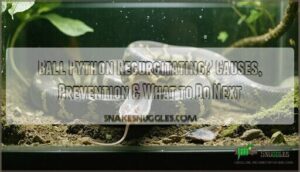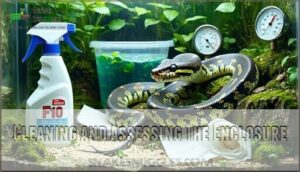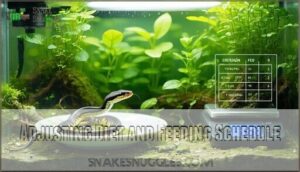This site is supported by our readers. We may earn a commission, at no cost to you, if you purchase through links.

Too-cold temperatures, handling too soon after a meal, or wrong-sized prey are often culprits. Stress or little husbandry hiccups like humidity swings, enclosure changes, or even parasites can shake up their system.
Clean up right away, double-check the tank’s warmth and humidity, and let your python rest before feeding again. If this happens twice or you spot illness signs, it’s time to see the vet.
Wondering how to make regurgitation a thing of the past?
Table Of Contents
Key Takeaways
- Keep your ball python’s enclosure warm and stable; temperature or humidity swings are top reasons for regurgitation. – Wait at least 48 hours after your snake eats before handling it, and always offer prey that’s the right size for your snake. – If your python regurgitates, clean the enclosure right away and let your snake rest for at least two weeks before feeding again. – If regurgitation happens twice or your snake looks unwell, see a reptile vet—underlying health issues might be at play.
Why is My Ball Python Regurgitating?
If your ball python throws up its meal, it’s usually a sign that something isn’t right with how you’re keeping or feeding it, or it could point to a health problem.
Knowing what usually causes a snake to throw up is key if you want to help your ball python get its digestion back on track and recover well.
Difference Between Regurgitation and Vomiting
If your ball python spits up right after eating, that’s usually regurgitation—a textbook sign of digestive trouble. Vomiting, on the other hand, is much rarer in snakes and tends to happen hours later.
If your ball python is regurgitating, chances are it’s dealing with a feeding issue or having trouble digesting its food.
But if your snake actually vomits—usually hours after eating—that’s usually a sign there’s something more serious going on with its health.
Knowing how to spot the difference lets you act quickly and keep your ball python’s digestive system in good shape.
Common Causes of Regurgitation
Now that you know the difference, let’s talk about why regurgitation happens. It’s usually one of three things:
- Temperature Fluctuation in the enclosure trips up digestion.
- Improper Handling right after a meal leads to vomiting.
- Inadequate Prey size or hidden Health Problems like parasite infections or GI obstruction cause snake digestive problems and other digestive issues.
Maintaining proper temperature control systems is essential to prevent regurgitation.
What Environmental Factors Cause Regurgitation?
Getting your ball python’s environment right is key for healthy digestion. Too much or too little heat, humidity, or even the wrong lighting can make them more likely to regurgitate their food.
Even small husbandry mistakes, like sudden enclosure changes, can cause significant stress and lead to regurgitation.
Temperature and Humidity Requirements
Picture the inside of your snake’s home—proper temperature gradients and humidity monitoring are the secret sauce for good digestion and easy shedding. Use heating methods with thermostat calibration to keep things steady.
Ball python needs 88-92°F in their basking zone and 50-60% humidity. Providing enough space to fully stretch out is also paramount for their well-being.
You’ll dodge regurgitation and shed troubles by nailing those environmental temperature targets.
Importance of Lighting and Photoperiod
Under the gentle glow of proper lighting, your ball python thrives. Maintaining a steady photoperiod benefits your snake by mimicking natural daylight, supporting their mood and metabolism.
Lighting effects, especially UVB light, boost immunity and appetite stimulation. Inconsistent lighting or missing a UVB importance checkmark can undermine even the best husbandry routines in snake husbandry.
Stress and Husbandry Mistakes
Lighting matters, but stress and husbandry mistakes often tip the scales. Handling stress is a leading cause—hold off after meals. Too small an enclosure limits movement and spikes snake stress. Lack of hiding spots means nowhere to relax.
When the substrate isn’t up to par or fresh water is hit-or-miss, your ball python’s health can quickly take a hit.
Stay on top of the basics and most problems won’t stand a chance.
How Can I Prevent Ball Python Regurgitation?
You can help prevent regurgitation in your ball python by maintaining stable enclosure temperatures, choosing proper prey, and minimizing stress.
Keeping up with good care and smart feeding choices goes a long way toward making sure your ball python stays healthy and digests food properly.
Proper Feeding Techniques and Prey Selection
Precision matters in snake feeding—choose prey items that match your ball python’s girth. A balanced snake diet with the right prey size goes a long way in preventing regurgitation.
Always use proper thawing methods for frozen prey to avoid digestive upsets.
Stick to a steady feeding schedule, and try mixing things up now and then by switching up the type of prey or adding a little scent to keep your snake interested.
Reducing Stress and Handling Risks
If you want to keep regurgitation out of your ball python’s routine, focus on safe handling and reducing stressors. Limit post-feed handling for at least 48 hours and watch your handling frequency. Provide a secure enclosure, be patient with nervous snakes, and practice proper husbandry. These steps make handling less dramatic and prevent unnecessary upsets.
- Wait 48 hours after feeding before handling
- Use gentle, slow movements for safe handling
- Keep handling sessions brief for new or stressed snakes
- Avoid loud noises and sudden changes in the enclosure area
- Make enclosures are secure to prevent escapes
Maintaining Stable Enclosure Conditions
Picture your ball python lounging in a perfect spa—stable enclosure conditions matter that much.
Keep those temperature gradients just right, watch the humidity stays between 50 and 70%, and try to stick to a regular lighting schedule.
Don’t cut corners on the size of the enclosure either, and avoid swapping substrates without good reason.
If environmental temperature or humidity swings, your snake’s comfort—and digestion—will go right out the window.
What Should I Do After Regurgitation Occurs?
If your ball python regurgitates, prompt action and careful observation are key to aid recovery. Quickly remove regurgitated material, assess enclosure conditions, and allow your snake time to rest before offering food again.
Cleaning and Assessing The Enclosure
After a regurgitation event, start with thorough enclosure sanitization using an F10 disinfectant. Remove soiled substrate and swap it for clean, easily monitored material.
Double-check hide placement and enrichment items for cleanliness and safety. Inspect humidity levels and environmental temperature.
Finish with a security check of latches and gaps—sound snake husbandry practices protect against repeat mishaps in your ball python’s enclosure.
Allowing Digestive Recovery Time
After a regurgitation event, your ball python needs time for digestive recovery. Don’t rush things—follow these snake feeding guidelines:
- Practice post-regurgitation fasting for at least two weeks.
- Gradually reintroduce food with a reduced meal size.
- Improve enclosure temperature for snake digestion.
- Schedule a veterinary consultation if regurgitation repeats, as underlying causes of snake regurgitation may threaten snake digestive health.
Adjusting Diet and Feeding Schedule
If your snake regurgitates, give it half-sized meals next time and hold off feeding for at least two weeks.
Try offering food in the late afternoon and switch things up—change prey types or add supplements—if your snake seems uninterested.
Consistency in feeding frequency and careful attention to diet helps ball pythons bounce back—feeding snakes is part science, part patient art.
When Does Regurgitation Mean a Vet Visit?
If your ball python regurgitates more than once or shows signs of illness like weakness or loss of appetite, it’s time to seek veterinary care.
Getting your snake checked quickly can help catch things like infections, digestive troubles, or other health problems before they get worse.
Signs of Underlying Illness
If your ball python’s energy flags or its appetite is off, it’s time to pay attention. Watch for:
- Lethargy and weakness after meals—don’t brush it off as laziness.
- Appetite depression or skipping meals.
- Noticeable behavioral changes or increased stress indicators.
- Changes in physical condition suggesting parasites, digestive health issues, or possible liver/kidney disease.
Monitoring for Recurring Issues
After a regurgitation incident, keep an eye on Regurgitation Frequency and track Weight Monitoring to spot potential snake health problems early. Note any Behavioral Changes, as these may signal a snake illness or issue with digestion.
Making small changes as you go can really help keep your snake healthy in the long run.
If problems keep happening, don’t wait—reach out to a vet who knows reptiles.
Diagnostic and Treatment Options
A skilled veterinarian will start with diagnostic tests, such as contrast radiography or fecal exams, to identify the cause of regurgitation and assess snake digestion.
Treatment ranges from medication options or dietary adjustments to, in rare cases, surgical intervention. Careful attention is needed during recovery.
Catching snake illnesses early makes all the difference for their long-term health.
Frequently Asked Questions (FAQs)
Can handling cause regurgitation during brumation or shedding?
If you handle your snake during brumation or shedding, think of it like waking someone in the middle of a nap—it can cause stress.
That stress often leads to digestive issues, including regurgitation, so give them space.
What role do parasites play in regurgitation episodes?
When unwelcome guests like parasites set up shop in a snake’s gut, digestion hits a snag. You’ll often see vomiting or appetite loss, so if the problem repeats, it’s time to see a reptile vet.
Is regurgitation more common in juvenile or adult pythons?
You’ll see regurgitation more in juveniles than adults, since their digestive systems aren’t fully developed.
If your young python “tosses its lunch,” don’t panic—just adjust husbandry and give it time to recover.
Are there specific medications that can trigger regurgitation?
Just like a sudden clap of thunder can unsettle a calm day, certain antibiotics, antiparasitics, or pain medications may upset your snake’s gut and trigger regurgitation.
Always consult a reptile-savvy vet before medicating.
Conclusion
Nearly 20% of captive ball pythons have experienced regurgitation at least once. If your ball python is regurgitating, pay careful attention to environmental factors and feeding practices.
Maintain proper temperature and humidity to foster healthy digestion. Avoid handling after meals, and choose appropriately sized prey.
Two consecutive regurgitations or signs of illness mean it’s time to see a vet. Address issues quickly to help your ball python recover and lessen future risk of regurgitation.
- https://reptilesmagazine.com/the-vet-report-reptile-vomiting-and-regurgitation/
- https://www.hvreptilerescue.org/resources/care-guides/ball-python-care-guide
- https://www.wilbanksreptiles.com/blogs/feeding-your-ball-python/the-ball-python-feeding-guide-how-often-should-you-feed-your-ball-python
- https://a-z-animals.com/blog/ball-python-feeding-chart/
- https://www.youtube.com/watch?v=7ci6HcKHC-Q














